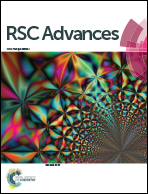Upconversion luminescence in sub-10 nm β-NaGdF4:Yb3+,Er3+ nanoparticles: an improved synthesis in anhydrous ionic liquids†
Abstract
Sub-10 nm β-NaGdF4:18% Yb3+,2% Er3+ nanoparticles were synthesized in ethylene glycol and various ionic liquids under microwave heating. The products were characterized by powder X-ray diffraction, electron microscopy, and upconversion (UC) luminescence spectroscopy. After Yb3+ excitation at 970 nm, Er3+ ions are excited by energy transfer upconversion and show the typical green and red emission bands. The UC luminescence intensity was optimized with respect to reactant concentrations, solvents, and reaction temperature and time. The strongest UC emission was achieved for sub-20 nm core–shell nanoparticles which were obtained in the ionic liquid diallyldimethylammonium bis(trifluoromethanesulfonyl)amide from a two-step synthesis without intermediate separation. Strictly anhydrous reaction conditions, a high fluoride/rare earth ion ratio, and a core–shell structure are important parameters to obtain highly luminescent nanoparticles. These conditions reduce non-radiative losses due to defects and high energy acceptor modes of surface ligands. A low power excitation of the core–shell particles by 70 mW at 970 nm results in an impressive UC emission intensity of 0.12% compared to the bulk sample.



 Please wait while we load your content...
Please wait while we load your content...